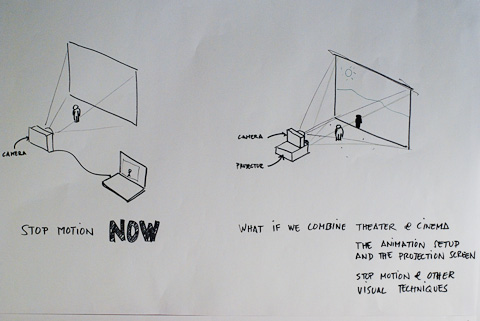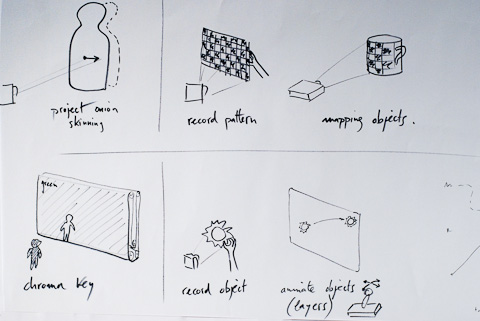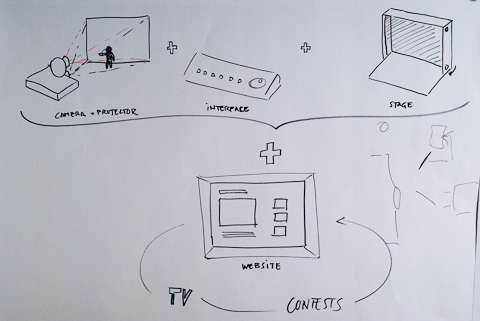A new paradigm for stop motion animation?
The exploration motivated me to find an adaptive solution for educational purposes in the field of animation. In my thesis I will explore potential improvements both on the technical and the educational side. I decided to start this exploration on both sides by introducing a paradigm shift regarding the typical animation setup. Normally a camera that captures the frames is connected to a computer that is used as interface, and to review the images, edit and display the final video. The animation process happens in one physical space, while the processing happens on a screen.
My concept is about combining both the stage and the projection space in one, having a camera and a projector pointing at the same area. That would lead into a stand-alone product without requiring an external computer for any of the stages of animating or watching the movies. At the same time, all the action, interaction and information related to the animation is happening in the same space.
This new setup automatically triggers many possibilities for teaching video or visual techniques (chromakey, projection mapping, etc. ) in a more tangible and intuitive way, without a computer.
Although these possibilities are really appealing to include on the set, they would not be the focus of my thesis. I would rather focus on simple tutorials to learn the basics of animation: physical kinematics, morph, walking cycle, etc. I would also to use stop-motion as a tool to teach other concepts not directly related to animation: colour mixing, elasticity, etc.
I find really important also to give this concept a social part, a way to exchange the movies and create an extra motivation. Children today are used to be online and share their activities virtually. A constructive way of doing it is building a system that enables children (or schools) to share the movies created with the kit, and see movies from others. It generates also opportunities to create collaborative movies in which a kid continues the work of another kid, or split the roles to create a longer movie. It also serves to get inspiration from others’ movies. Building an online community also facilitates to spread the material created with the device, and build connections with local TV’s or film contests.
So, the design challenge:
How might I create a tool that helps teaching the basics of animation to children in a meaningful, intuitive and playful way? How might I provide a solution that could be sold as a product? How might I bring back the tangibility of the animation and editing techniques of the past times? How might I build a stronger bridge between abstract concepts on different content areas in education and reality, through an innovative animation process?
The design work can be split in three parts that will be carried out in parallel:
A – the physical setup that allows capturing the animation and project the result,
B – the interface to operate this product,
C – the sets of objects that allow an enhanced educational process.
In the first part I’ll make experiments to define the best setup using a camera and a projector, basically in terms of angle between them, light conditions on the room, etc. I’d also like to explore new places to animate – normally is done on a table, but for example under it would be a good space. This could bring new positions for the camera and projector (vertical, 45º angle, etc.)
In the second part I’ll define, prototype, test and refine the interface for the target group and features that better provide a learning and fun experience.
In the third part I’ll design the set of objects that allow to learn the basics of animation, and also explore with experiments that bring a better understanding over other content areas, as physics or art. This phase will include shape and material exploration, as well as motion cycles experimentation.
During the exploration and development I’d like to focus on delivering a high quality product, experience and sets of objects that fulfill the purpose of the device. It will be tempting to explore the possibilities that the new setup allows, but within the short time frame of the project (six weeks of work from now) I should stick to deliver a simple and meaningful solution, for a specific target. Specially the conception of the user interface will be much easier if the target is well defined and possibilities of the device are narrowed down to the most basic and most powerful ones.
It’s a product for educators (parents or teachers at school) and children. It’s a design for the present that hopefully would fit also in the future.
Tags: concept, finalproject



June 18th, 2010 at 10:35 am
have a look at this one.
http://www.joachimsauter.com/en/projects/vro.html
June 18th, 2010 at 10:38 am
http://www.artcom.de/index.php?option=com_acprojects&page=6&id=29&Itemid=115&details=0&lang=en